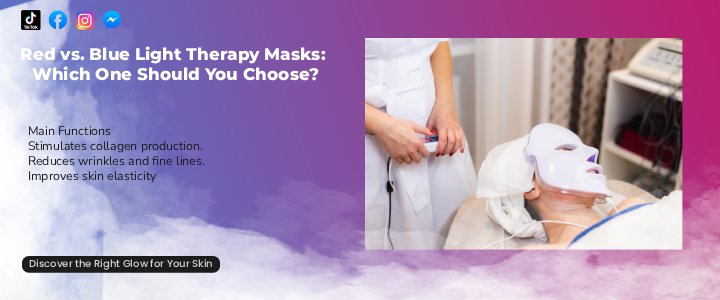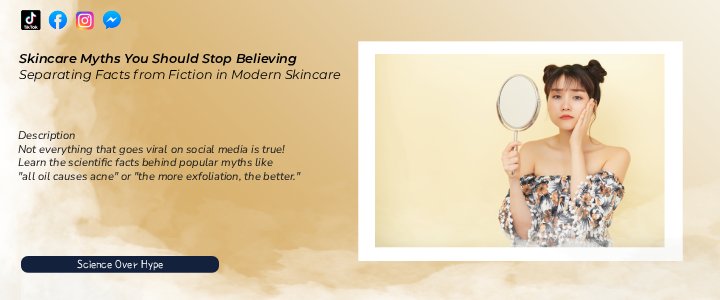Red and Blue Light Therapy Masks
When it comes to at-home skincare devices, light therapy masks have quickly become a must-have. Among the most popular options are red light and blue light therapy masks, each offering unique benefits for your skin. But how do you know which one is right for you? Understanding the differences between these two types of light therapy is the first step toward achieving your best skin yet.
In this article, we’ll break down the science behind red and blue light therapy, what skin concerns each type targets, the pros and cons of both, and even how you can combine them for maximum results. Whether you’re fighting acne, reducing fine lines, or calming inflammation, this guide will help you choose the right mask for your skincare need
Difference Between Red and Blue Light Therapy
The primary difference between red and blue light therapy lies in their wavelength and depth of penetration. Red light therapy uses wavelengths typically between 630–700 nanometers, allowing it to penetrate deeper into the skin. This makes it effective for stimulating collagen production, improving circulation, and reducing inflammation.
Blue light therapy, on the other hand, uses shorter wavelengths (around 400–490 nanometers). These wavelengths stay closer to the skin’s surface and are highly effective at killing acne-causing bacteria. Because of this, blue light is often recommended for oily or acne-prone skin.
Curious about why the INIA Red Light Therapy Mask is trending? Check out our in-depth review to see what makes it a favorite among users.
INIA Red Light Therapy Mask
Skin Concerns Each Type Targets
Before choosing a light therapy mask, it’s helpful to know which concerns each type of light can address.
Here’s a breakdown of the most common skin concerns for each type of therapy:
1.Red Light Therapy:
- Fine lines and wrinkles
- Loss of skin elasticity
- Dull or uneven skin tone
- Inflammation and redness
- Support for wound healing
2. Blue Light Therapy:
- Acne breakouts and blackheads
- Clogged pores
- Oily skin regulation
- Prevention of future breakouts
As you can see, red light therapy is best for anti-aging and overall skin rejuvenation, while blue light therapy focuses on acne and bacteria control.
Both therapies can be game-changers when used consistently. Understanding your skin’s specific needs is the key to choosing the right one.
Pros and Cons of Each
Each type of light therapy comes with its own strengths and limitations. Let’s weigh the pros and cons of red and blue light therapy:
A1. Red Light Therapy Pros:
- Boosts collagen and elastin production
- Improves circulation and skin texture
- Reduces redness and swelling
- Suitable for most skin types
A2. Red Light Therapy Cons:
- Results take several weeks to become visible
- May not directly treat acne
B1. Blue Light Therapy Pros:
- Kills acne-causing bacteria effectively
- Reduces existing breakouts
- Helps prevent future acne flare-ups
B2. Blue Light Therapy Cons:
- May cause temporary dryness or irritation
- Does not target aging concerns
By knowing these pros and cons, you can choose a therapy that aligns with your skincare priorities and lifestyle.
Who Should Use Red vs. Blue Light Therapy
- Choosing the right mask comes down to your skin goals.
- Red light therapy is ideal if you’re dealing with early signs of aging, sagging skin, or post-inflammatory redness.
- Blue light therapy is best if acne is your main concern and you want a non-invasive way to reduce breakouts.
If you have combination skin or multiple concerns, don’t worry—there’s a way to get the best of both worlds.
Combining Both for Maximum Results
Many modern light therapy masks now offer dual or multi-light settings, allowing you to switch between red and blue light—or even use both in the same session.
This combination approach can be powerful:
- Start with blue light to kill bacteria and clear pores.
- Follow with red light to calm inflammation and encourage skin healing.
Using both therapies together helps you address acne while also improving overall skin health and preventing premature aging.
Discover the top 7 benefits of using a light therapy mask at home to improve your skin health, boost your mood, and enhance your overall wellness. Read the full article here.
Benefits of Using a Light Therapy Mask
Whether you choose red light therapy for anti-aging benefits or blue light therapy for acne control, both can play an important role in a healthy skincare routine. The key is consistency—regular use of your light therapy mask will produce the best results over time.
If you have multiple skin concerns, consider a mask that offers both red and blue light modes for a well-rounded treatment. By understanding the differences and benefits of each, you can make an informed decision and achieve glowing, healthy skin.



